Prehistoric Italy
Part of a series on the |
|---|
| History of Italy |
 |
|
|
|
|
| Italy portal |
The prehistory of Italy begins with the arrival of the first hominins 850,000 years ago [1] and ends in the Iron Age, when the first written records appeared in the peninsula.
Paleolithic
In prehistoric times, the Italian peninsula was rather different from how it is now. During glaciations, for example, the islands of Elba and Sicily were connected to the mainland. The Adriatic Sea began at what is now the Gargano Peninsula, and what is now its surface up to Venice was a fertile plain with a humid climate.
The presence of Homo neanderthalensis has been demonstrated in archaeological findings dating to c. 50,000 years ago (late Pleistocene). There are some twenty such sites, the most important being that of the Grotta Guattari at San Felice Circeo, on the Tyrrhenian Sea south of Rome. Other are the grotta di Fumane (province of Verona) and the Breuil grotto, also in San Felice.
The first Cro Magnon inhabitants of Italy, perhaps coming from a migration started from Apulia, moved across the peninusula, establishing themselves in small settlements far from each one, most on high areas. In November 2011 tests conducted at the Oxford Radiocarbon Accelerator Unit in England on what were previously thought to be Neanderthal baby teeth, which had been unearthed in 1964 from the Grotta del Cavallo, were identified as the oldest modern human remains discovered anywhere in Europe, dating from between 43,000 to 45,000 years ago.[2] Around 12,000 years ago, the diminishing number of big game forced their descendants to populate the coast areas.
In 2011 it has been discovered the most ancient Sardinian complete human skeleton (called Amsicora ) at Pistoccu, in Marina di Arbus; scientists date it back to 8500 years ago (the transition period between the Mesolithic and Neolithic ).[3]
Neolithic
Cardium Pottery is a Neolithic decorative style that gets its name from the imprinting of the clay with the shell of the Cardium edulis, a marine mollusk. The alternative name Impressed Ware is given by some archaeologists to define this culture, because impressions can be with sharp objects other than Cardium shell, such as a nail or comb.[4]

Impressed Ware is found in the zone "covering Italy to the Ligurian coast" as distinct from the more western Cardial beginning in Provence, France and extending to western Portugal.
This pottery style gives its name to the main culture of the Mediterranean Neolithic, which eventually extended from the Adriatic sea to the Atlantic coasts of Portugal and south to Morocco.[5]
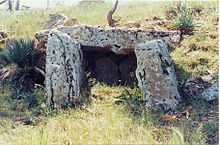
Since the Late-Neolithic, Aosta Valley and Sardinia in particular were involved in the pan-Western European Megalithic phenomenon. Later, in the Bronze Age, megalithic structures were built also in Latium, Puglia and Sicily.[6] This latter region, around the end of the third millennium b.C. imported from Sardinia typical cultural aspects of Atlantic world, including the Culture of small dolmen-shaped structures that reached all over the Mediterranean basin.[7]
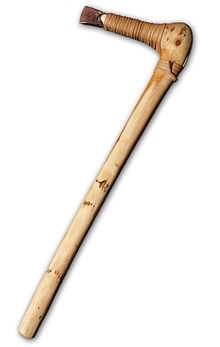
Copper Age
The Remedello, Rinaldone and Gaudo cultures are late Neolithic cultures of Italy, traces of which are primarily found in the present-day regions of Lombardy, Tuscany, Latium and Campania. They are sometimes described as Eneolithic cultures, due to their use of primitive copper tools. Other importants eneolithic cultures of the peninsula and the islands, often related to those previously mentioned, are the Laterza culture in Apulia and Basilicata, the Abealzu-Filigosa culture in Sardinia, the Conelle-Ortucchio culture in Abruzzo and Marche, the Serraferlicchio culture in Sicily, and the Spilamberto group in Emilia-Romagna.
The earliest Statue menhirs, frequently depicting weapons, were erected by the populations of northern Italy, Apulia, and Sardinia during this period. This sculptural tradition of possible steppe origin (Yamna culture),[8] lasted in some regions well into the Bronze Age and even into the Iron Age.[9]
The Beaker culture marks the transition between the Eneolitichic and the early Bronze Age.
.png)
Bronze Age
Polada culture
Nuragic civilization
Located in Sardinia and southern Corsica, the Nuragic civilization, who lasted from the early Bronze Age (18th century BC) to the 2nd century AD when the islands were already Romanized, evolved from the pre-existing megalithic cultures that built dolmens(circa 100) and menhirs (more than 400), more than 2,400 Domus de Janas and also an important altar of Monte d'Accoddi that remember a mesopotamic Ziqqurat.
It take his name from the characteristic Nuraghe. The nuraghe towers are unanimously considered the best preserved and largest megalithic remains in Europe. Their effective use is still debated: some scholars considered them as monumental tombs, others as Houses of the Giants, other as fortresses, ovens for metal fusion, prisons or, finally, temples for a solar cult.
A warrior and mariner people, the ancient Sardinians held flourishing trades with the other Mediterranean peoples. This is showed by numerous remains contained in the nuraghe, such as amber coming from the Baltic Sea, small bronzes portraying African apes and animals, copper nuggets and weapons from Eastern Mediterranean, Mycenaean ceramics. It has been hypothesized that the ancient Sardinians, or part of them, could be identified with the Sherden, one of the so-called People of the Sea who attacked ancient Egypt and other regions of eastern Mediterranean.
Other original elements of the Sardinian civilization include the temples known as "Sacred Pits", perhaps dedicated to the holy water related to the Moon and astronomical cycles, the Giants' graves, the Megaron temples, several structures for juridical and leisure functions, some bronze refined statuettes and some of them have been discovered in Etruscan tombs, suggesting a strong relationships between the two peoples. Another important element of this civilitation are The Giants of Mont'e Prama , the oldest statues of Mediterranean sea.
Sicily
Apennine culture
The Apennine culture is a cultural complex of central and southern Italy spanning the Bronze Age.
The people of the Apennine culture were cattle herdsmen grazing their animals over the meadows and groves of mountainous central Italy, however their range was not necessarily confined to the hills. They lived in small hamlets located in defensible places. On the move between summer pastures they built temporary camps or lived in caves and rock shelters. Their pottery has been found on the Capitoline Hill at Rome.
Terramare
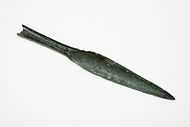
The Terramare was a Middle and Recent Bronze Age culture, between the 16th and the 12th centuries BC, in the area of what is now Pianura Padana (specially along the Panaro river, between Modena and Bologna), probably developed by the early Italics.[10] They lived in villages constituted of wooden stilt houses: they had a square shape, built on the mainland but generally near a stream, with roads that crossed each other at right angles. The whole complex denoted the nature of a fortified settlement.
It has been suggested that the Terramare of Emilia acted as stores and starting points for trades of the Baltic amber and the tin from Erzgebirge through the Val Camonica and the Po River, towards the Eastern Mediterranean Sea and Greece.
Around the 12th century BC the Terramare system collapsed, the settlementes were abandoned and the populations moved southward, where they mingled with the Apennine peoples.[10]
Castellieri
The Castellieri civilization developed in Istria during the Mid-Bronze Age, and later expanded into Friuli, the modern Venezia Giulia, Dalmatia and the neighbouring areas. It lasted for more than a millennium, from the 15th century BC until the Roman conquest in the 3rd century BC. It takes its name from the fortified boroughs (Castellieri, Friulian cjastelir) which characterized the culture.
The ethnicity of the Castellieri civilization is uncertain, although it was most likely of Pre-Indoeuropean stock, coming from the sea. The first castellieri were indeed built along the Istrian coasts and present the same Megalithic appearance characterizing in the Mycenaean civilization at the time. Hypotheses about an Illyrian origin of the people are not confirmed.
The Castellieri were fortified boroughs, usually located on hills or mountains or, more rarely (such as in Friuli), in plains. They were constituted by one or more concentric series of walls, of rounded or elliptical shape in Istria and Venezia Giulia, or quadrangular in Friuli, within which was the inhabited area.
Some a hundred of castellieri have been discovered in Istria, Friuli and Venezia Giulia, such as that of Leme, in the central-western Istria, of the Jelarji, near Muggia, of Monte Giove near Prosecco (Trieste) and San Polo, not far from Monfalcone. However, the largest castelliere was perhaps that of Nesactium, in the southern Istria, not far from Pula.
Canegrate
The Canegrate culture developed from the mid-Bronze Age (13th century BC) till the Iron Age in the Pianura Padana, in what is now western Lombardy, eastern Piedmont and Ticino. It takes its name from the township of Canegrate where, in the 20th century, some fifty tombs with ceramics and metal objects were found.
Canegrate terracotta is very similar to that known from the same period north to the Alps (Provence, Savoy, Isère, Valais, the area of Rhine-Switzerland-eastern France). The members of the culture have been described as a warrior population who had descended to Pianura Padana from the Swiss Alps passes and the Ticino.
Proto-Villanovan culture
Iron Age
Villanova
The name of this Iron Age civilization derives from a locality in the frazione Castenaso of Bologna, in Emilia, where a necropolis was discovered by Giovanni Gozzadini in 1853-1856.
The main characteristic of the Villanovans (with some similarities with the so-called Proto-Villanovan epoch of the late Bronze Age) were the incinerated sepultures, in which the dead's ashes were housed in double-cone shaped urns.
The Villanovan were initially devoted to agriculture and breeding, with a simplified social order. Later, specialized craftmanship activities such as metallurgy and ceramics created an accumulation of richness, which caused the appearance of social stratification.
Latial culture
Este culture
Golasecca
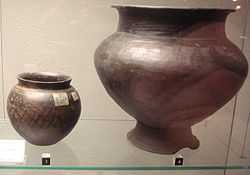
The Golasecca culture developed starting from the early Iron Age in the northwestern Po plain. It takes its name from Golasecca, a locality next to the Ticino where, in the early 19th century, abbot Giovanni Battista Giani excavated its first findings (some fifty tombs with ceramics and metal objects). Remains of the Golasecca culture span an area of c. 20,000 square kilometers south to the Alps, between the Po, Sesia and Serio rivers, dating from the 9th to the 4th century BC.
Their origins can be directly traced from that of Canegrate and to the so-called Proto-Golasecca culture (12th-10th centuries BC). Recent excavations have proved the continuity of the culture after the Celtic invasion from France around 390/380 BC. The Golasecca culture traded with the Etruscans and the Halstatt culture on the north, later reaching the Greek world (oil, wine, bronze objects, ceramics and others) and northern Europe (tin and amber from the Baltic coast).
In a Golasecca culture tomb in Pombia has been found the oldest known remain of common hop beer in the world.
.jpg)
The Camuni
The Camuni were an ancient people of uncertain origin (according to Pliny the Elder, they were Euganei; according to Strabo, they were Rhaetians) who lived in Val Camonica – in what is now northern Lombardy – during the Iron Age, although human groups of hunters, shepherds and farmers are known to have lived in the area since the Neolithic.
They reached the height of their power during the Iron Age due to the presence of numerous iron mills in Val Camonica. Their historical importance is, however, mostly due to their legacy of carved rocks, c. 300,000 in number, which date from the Palaeolithic to the Middle Ages.
Pre-Roman period
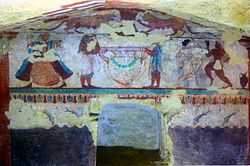
Among the populations of pre-Roman Italy, the most notable were the Etruscans who, starting from the 8th century BC, created a refined civilization which largely influenced Rome and the Latin world. The origins of this non-Indo-European people, which originated from the Tyrrhenian coast of central Italy and later expanded to Emilia and Campania, are uncertain.
Other peoples living in northern Italy include the Ligurians (an Indo-European people who lived in what is now Liguria, southern Piedmont and the southern French coast), and the Veneti of north-eastern Italy, who probably came from Illyria or, according to other studies, Asia Minor. In the peninsula, alongside the Etruscans, lived numerous tribes, mostly of Indo-European origin: the Umbri in Umbria, Latins, Sabellians, Falisci, Volsci and Aequi in the Latium; Piceni in the Marche and northern Abruzzo; Samnites in southern Abruzzo, Molise and Campania; Daunians, Messapii and Peucetii (forming the Apulian or Iapygian confederation) in Apulia; Lucani and Bruttii in the southern tips of the peninsula; Sicels, Elymians and Siculi in Sicily. Sardinia was still inhabited by the Nuragic peoples. Apart from the Latins (who created the Roman civilization), the most successful were perhaps the Samnites, who were able to create a large federation across the central Apennines and effectively opposed the Roman expansions until the Samnite Wars.
Some of these peoples living in southern Italy (also known as Magna Graecia), Sicily and Sardinia from the 8th to the 3rd century, lived alongside new colonies founded by Phoenicians and Greeks, and were later absorbed into the Roman state.
See also
- Ancient peoples of Italy
- Italic languages
Notes
- ↑ National Geographic Italia - Erano padani i primi abitanti d’Italia(Italian)
- ↑ Wilford, John Noble (2 Nov 2011). "Fossil Teeth Put Humans in Europe Earlier Than Thought". New York Times. Retrieved 2012-04-19.
- ↑
- ↑ "Impressed Ware Culture". The Concise Oxford Dictionary of Archaeology. Retrieved 2008-05-11.
- ↑ Antonio Gilman, Neolithic of Northwest Africa, Antiquity,vol 48, no. 192 (1974), pp 273-282.
- ↑ Artepreistorica.com - MEGALITISMO DOLMENICO DEL SUD-EST ITALIA NELL´ETA´ DEL BRONZO(Italian)
- ↑ Salvatore Piccolo (2013), Ancient Stones: The Prehistoric Dolmens of Sicily. Abingdon/GB, Brazen Head Publishing.
- ↑ Francesco Fedele - La società dell’età del Rame nell’area alpina e prealpina(Italian)
- ↑ Museo delle Statue Stele Lunigianesi - Le statue stele in Italia e in Europa(Italian)
- ↑ 10.0 10.1 Andrea Cardarelli - The collapse of the Terramare culture and growth of new economic and social system during the late Bronze Age in Italy
Sources
- Anati, Emmanuel (1964). La civiltà di Val Camonica. Milan: Il Saggiatore.
- Gianna G. Buti e Giacomo Devoto, Preistoria e storia delle regioni d'Italia, Sansoni Università, 1974